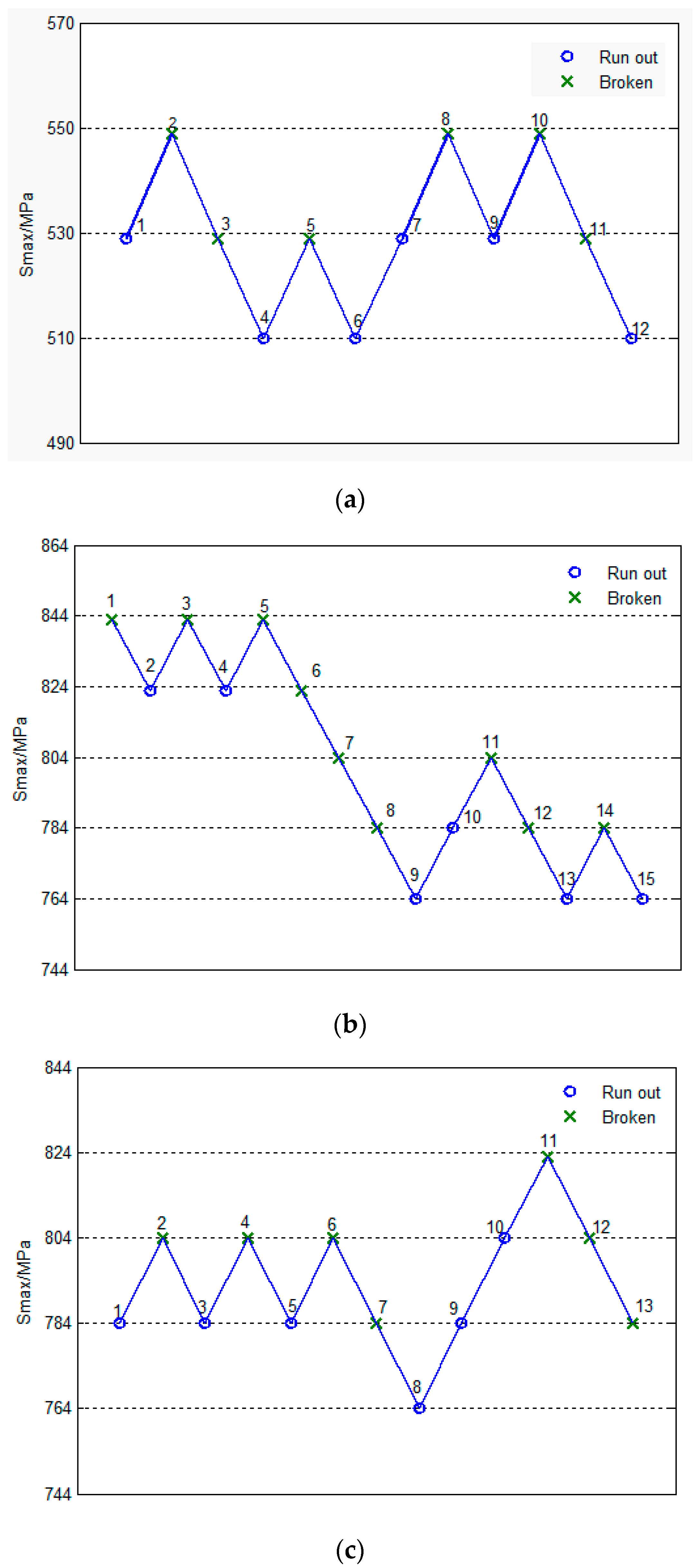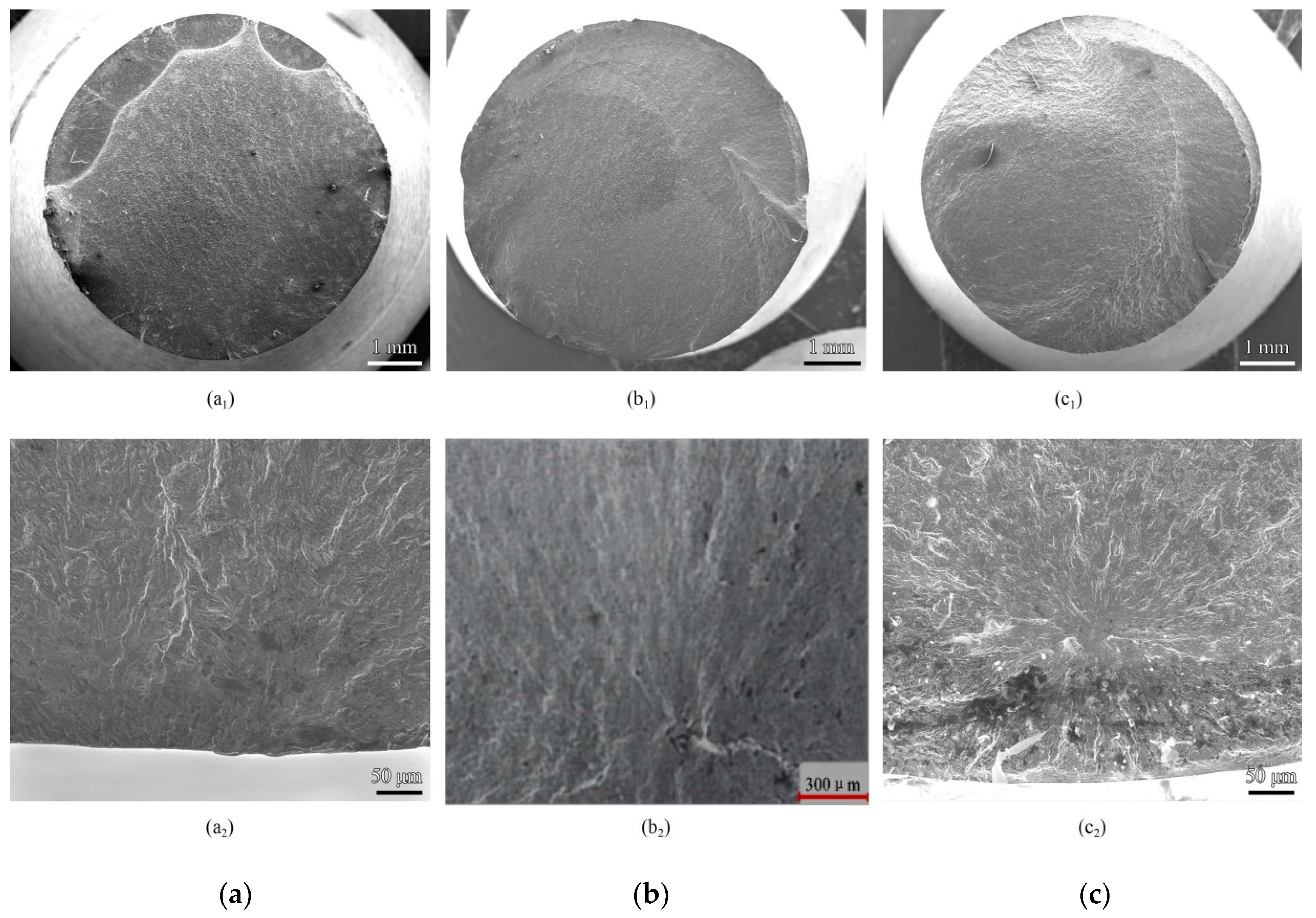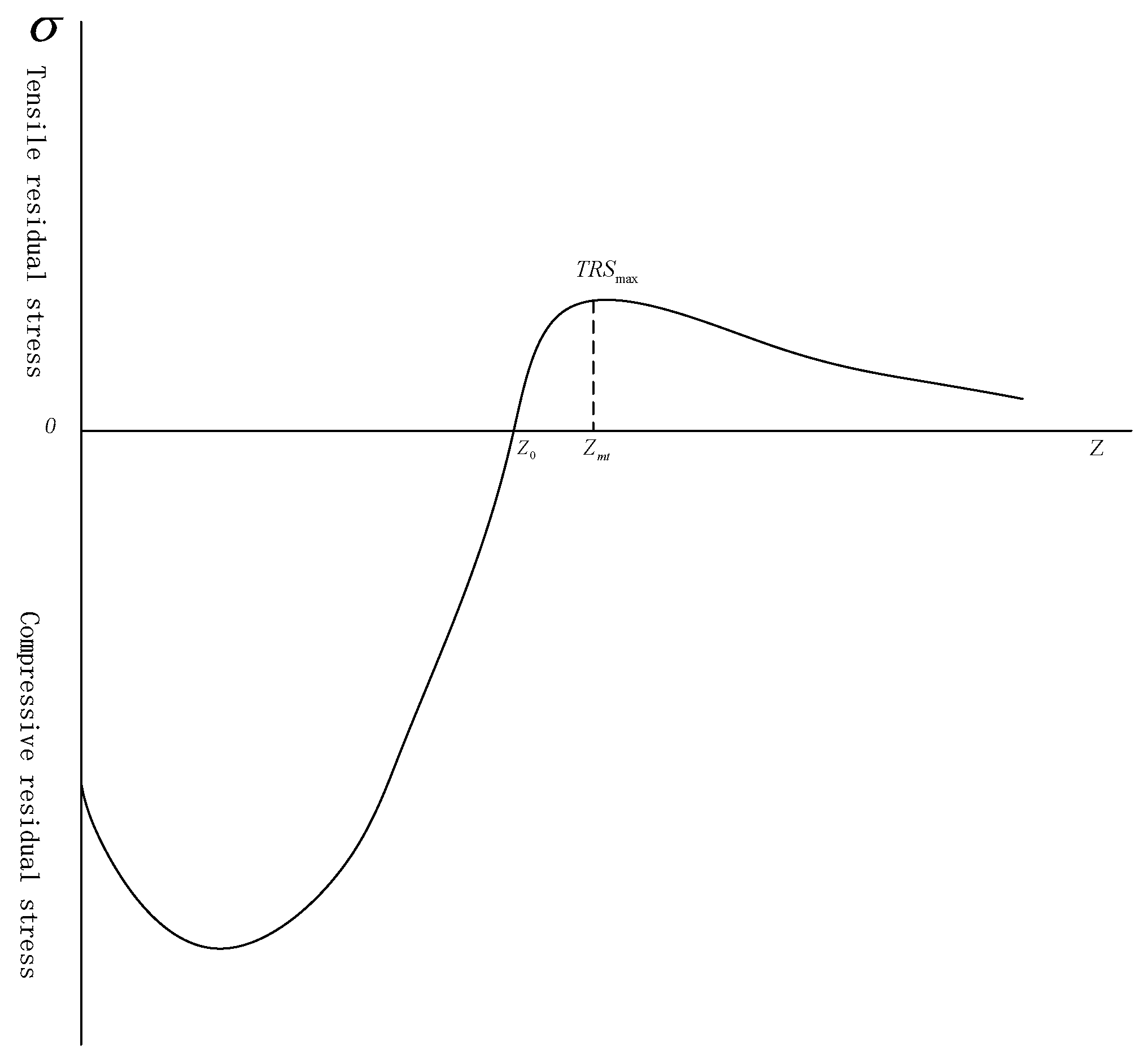Fatigue Limit of Custom 465 with Surface Strengthening Treatment
Abstract
:1. Introduction
2. Materials and Experiments
2.1. Materials
2.2. Experiments
3. Results and Discussion
3.1. Residual Stress
3.2. Micro-Hardness
3.3. Fatigue Limit
3.3.1. Test Results
3.3.2. Predictive Results
4. Conclusions
- (1)
- Shot peened or nitrided surface strengthening treatment form a favorable compressive residual stress and micro-hardness distribution state on the surface of Custom 465.
- (2)
- Shot peened or nitrided surface strengthening treatment can significantly increase the fatigue limit of Custom 465, and the effect of nitrided and shot peened increase the fatigue limit was not significant, that was, about 50%.
- (3)
- The fatigue crack source of the un-surface strengthened specimen is located on the surface, while the fatigue crack source of the strengthened specimen is located on the sub-surface under the strengthened layer.
- (4)
- The relationship between the internal fatigue limit and the surface residual stress of the surface strengthened specimen can be used as a method for predicting the fatigue limit of the surface strengthened specimens.
Author Contributions
Funding
Conflicts of Interest
References
- Daymond, B.T.; Binot, N.; Schmidt, M.L.; Preston, S.; Collins, R.; Shepherd, A. Development of Custom 465® Corrosion-Resisting Steel for Landing Gear Applications. J. Mater. Eng. Perform. 2016, 25, 1539–1553. [Google Scholar] [CrossRef] [Green Version]
- Moriyama, M.; Nagano, T.; Kawagoishi, N.; Takaki, S.; Nagashima, E. Effect of Shot Peening on Fatigue Strength of 18%Ni Maraging Steel. JSME Int. J. 2002, 44, 301–308. [Google Scholar] [CrossRef] [Green Version]
- Zhang, X.; Jie, X.; Zhang, L.; Luo, S.; Zheng, Q. Improving the high-temperature oxidation resistance of H13 steel by laser cladding with a WC/Co-Cr alloy coating. Anti-Corros. Methods Mater. 2016, 63, 171–176. [Google Scholar] [CrossRef]
- Torres, M.A.S.; Voorwald, H.J.C. An evaluation of shot peening, residual stress and stress relaxation on the fatigue life of AISI 4340 steel. Int. J. Fatigue 2002, 24, 877–886. [Google Scholar] [CrossRef]
- Segursdo, E.; Belzunce, F.J.; Fernandez, P.I. Fatigue Resistance Study of Quenched and Tempered High-Strength Steel Submitted to Low Intensity Shot Peening Treatments with Different Types of Shots. J. Mater. Sci. Eng. 2017, 6, 1000401. [Google Scholar]
- Trung, P.Q.; Win, K.N.; Butler, D. Effect of shot peening process on the fatigue life of shot peened low alloy steel. J. Eng. Mater. Technol. 2018, 140, 011013. [Google Scholar] [CrossRef]
- Klotz, T.; Delbergue, D.; Bocher, P.; Lévesque, M.; Brochu, M. Surface characteristics and fatigue behavior of shot peened Inconel 718. Int. J. Fatigue 2018, 110, 10–21. [Google Scholar] [CrossRef]
- Guagliano, M. Experimental Analysis on the Fatigue Threshold Behaviour of a Nitrided and Shot Peened Steel. Key Eng. Mater. 2007, 348, 865–868. [Google Scholar] [CrossRef]
- Terres, M.A.; Laalai, N.; Sidhom, H. Effect of nitriding and shot-peening on the fatigue behavior of 42CrMo4 steel: Experimental analysis and predictive approach. Mater. Des. 2012, 35, 741–748. [Google Scholar] [CrossRef]
- Croccolo, D.; Cristofolini, L.; Bandini, M.; Freddi, A. Fatigue strength of shot-peened nitrided steel: Optimization of process parameters by means of design of the experiment. Fatigue Fract. Eng. Mater. Struct. 2002, 25, 695–707. [Google Scholar] [CrossRef]
- Li, J.K.; Li, H.T.; Yao, M. Investigation on the tensile residual stress due to shot peening and the internal fatigue limit of materials. Acta Aeronaut. Astronaut. Sin. 1990, 11, 369–375. [Google Scholar]
- Wang, R.Z.; Li, X.B.; Wu, H. Relationship etween shot peening surface strain layer and fatigue strength of high strength aluminium alloy. Aeronaut. Mater. 1985, 6, 250–257. [Google Scholar]
- Qiu, Q.; Wang, R.Z. Static roading Relaxation of Residual Stress and the Optimum Residual Stress Field Induced by Shot Peening. Met. Sci. Technol. 1988, 5, 47–54. [Google Scholar]







| Specimen | Fatigue Limit | Deviation | |
|---|---|---|---|
| Test Results | Predictive Results | ||
| Un-surface strengthened | 529 MPa | - | - |
| Shot peened | 797 MPa | 879 MPa | 10.3% |
| Nitrided | 794 MPa | 876 MPa | 10.4% |
© 2020 by the authors. Licensee MDPI, Basel, Switzerland. This article is an open access article distributed under the terms and conditions of the Creative Commons Attribution (CC BY) license (http://creativecommons.org/licenses/by/4.0/).
Share and Cite
An, G.; Liu, R.-j.; Yin, G.-q. Fatigue Limit of Custom 465 with Surface Strengthening Treatment. Materials 2020, 13, 238. https://doi.org/10.3390/ma13010238
An G, Liu R-j, Yin G-q. Fatigue Limit of Custom 465 with Surface Strengthening Treatment. Materials. 2020; 13(1):238. https://doi.org/10.3390/ma13010238
Chicago/Turabian StyleAn, Gang, Ren-jing Liu, and Guang-qiang Yin. 2020. "Fatigue Limit of Custom 465 with Surface Strengthening Treatment" Materials 13, no. 1: 238. https://doi.org/10.3390/ma13010238




